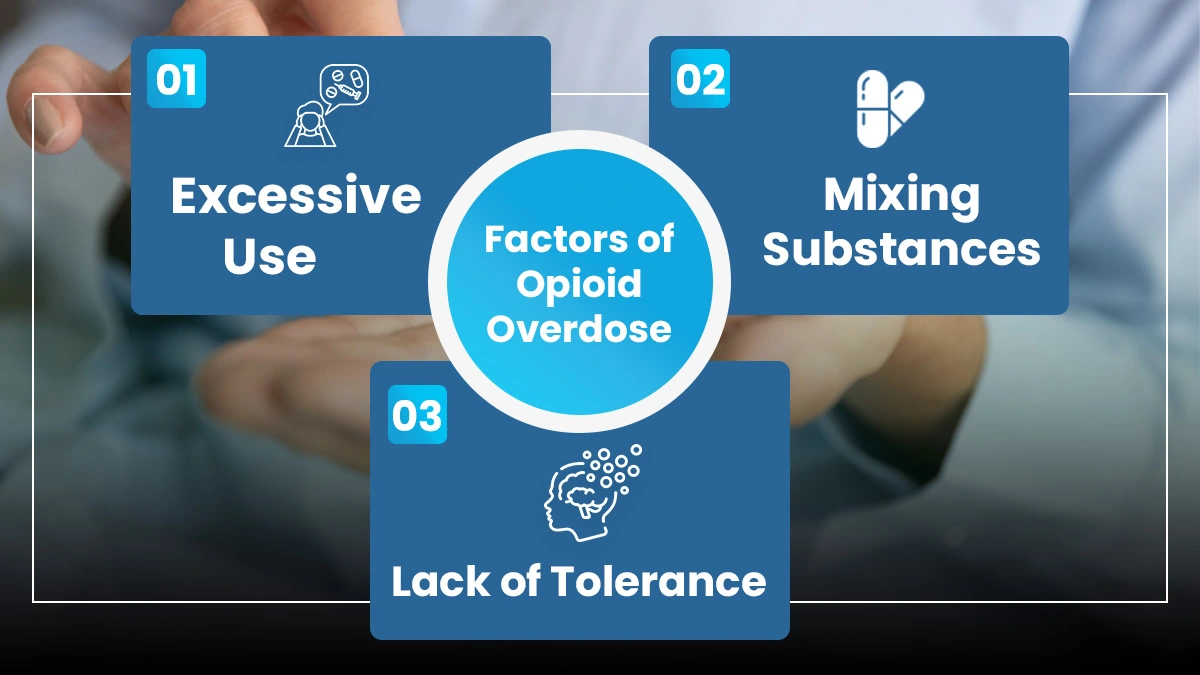Understanding Opioid Overdose
An opioid overdose happens when someone takes too much of certain drugs, like prescription painkillers or illegal substances such as heroin. That can dangerously slow down critical bodily functions, especially breathing. Signs include severe drowsiness, dissociation from surroundings, and trouble breathing.
Quick medical help, often using a medication called naloxone, is vital to reverse the overdose and prevent serious harm or death. Opioid overdoses are a major public health issue requiring treatment services for long-term recovery. It is vital to spread awareness, take preventive measures, and ensure widespread access to life-saving resources to tackle the opioid epidemic.
Key Takeaways
An opioid overdose occurs when excessive opioid intake dangerously slows down breathing. Here’s what you need to know:
- Opioid overdose causes physical signs such as loss of consciousness and behavioral changes, requiring opioid overdose intervention.
- Various programs, such as harm reduction, are working to promote awareness and safety regarding opioid use among individuals.
- In case of an overdose, it is best to stay with the person and call for emergency help.
The Haven Detox-New Jersey can help you beat opioid addiction. Contact us at (856) 565-3102 to learn about our services.

The Rise of the Opioid Crisis
The surge of the opioid crisis is mainly fueled by oxycodone, fentanyl, and synthetic opioids (excluding methadone), serving as the primary cause of drug overdose deaths. According to the Centers for Disease Control and Prevention, almost 88% of opioid-related overdose fatalities are linked to synthetic opioids.
In 2021, opioids were implicated in a staggering 80,411 overdose deaths, making up 75.4% of all drug overdose fatalities. This crisis affects individuals across the United States, impacting communities nationwide. Illicit drugs contribute significantly to the problem, affecting the country as a whole. Addressing opioid-related overdose requires understanding the factors of overdose and implementing strategies. That will safeguard people from the devastating consequences of this widespread issue.
Factors of Opioid Overdose
Understanding these common causes is essential to prevent serious consequences. Excessive opioid use, mixing substances, and lack of tolerance are key factors contributing to the rising number of overdoses.
Excessive Use
One common cause of opioid overdose is the consumption of excessive amounts of opioids purchased from pharmacies or the black market. Individuals who take more opioids than their prescribed dose or use them beyond recommended limits face an increased risk of overdose. That includes both prescription opioids and illicit substances like fentanyl.
Mixing Substances
Combining opioids with other substances, especially alcohol or sedatives, can escalate the cases of overdose. Mixing different drugs amplifies their effects and can overwhelm the body’s ability to process them safely, heightening the danger of respiratory distress and other life-threatening complications.
Lack of Tolerance
Individuals with a low tolerance to opioids, whether due to recent initiation or a period of reduced use, are at a higher risk of overdose. This vulnerability extends to both prescription opioids prescribed for pain management and illicit drugs, particularly those containing potent substances like fentanyl.
Warning Signs of Opioid Overdose
Recognizing the signs of an opioid overdose is crucial for timely intervention. Here are the signs of overdose you should know:
Physical Symptoms
During an opioid overdose, individuals may display physical symptoms such as extremely slowed breathing or respiratory failure, leading to a bluish tint in the skin. Pinpoint pupils, excessive drowsiness, and loss of consciousness are also indicative signs. It can also cause nausea and vomiting, which may lead to choking and aspiration. If someone exhibits these signs of opioid overdose, immediately call for emergency services.
Behavioral Signs
Behavioral indicators of an opioid overdose include confusion, unresponsiveness, and an inability to stay awake. The person’s body may feel limp or floppy, and muscle tone may be significantly reduced due to opioid intoxication.
Recognizing these behavioral signs is crucial, as opioids’ effects on the central nervous system can be life-threatening. In cases where someone is experiencing an overdose, starting rescue breathing immediately can be a crucial step in preventing harm.
Preventing Opioid Overdose
Individuals using opioids by sharing syringes not only trigger overdose but are a leading cause of HIV. Prevention of such incidents involves a holistic approach, such as harm reduction strategies to lower the risks of fentanyl and other opioids. Individuals with opioid use disorder, as well as healthcare providers and communities, play crucial roles in implementing effective preventive measures.
- Utilize fentanyl test strips to detect the presence of potent opioids.
- Engage in syringe service programs for safer drug use.
- Promote safe practices and informed decision-making among adults and teens.
- Distribute naloxone (Narcan) to reverse opioid overdoses.
- Educate individuals on prompt naloxone administration within seconds of an overdose.
- Prescribe naloxone to individuals at higher risk of overdose.
By applying these prevention strategies, communities can work towards reducing the incidence of opioid overdoses. That fosters a safer environment for individuals with opioid use disorder.
First Aid Response for Opioid Overdose
If someone overdoses on opioids, quick first aid is crucial. Call for emergency help right away. Check if the person is breathing; if not, start rescue breathing. Lay the person on their back, open the mouth, and clear any blockages. Administer naloxone if available. Keep the person awake and responsive. Avoid leaving them alone.
If high doses of opioids are involved, the effects can be severe, so getting professional help is important. Always follow the guidance of the emergency department and healthcare providers to ensure the best care for someone experiencing an opioid overdose. To help a person recovering from an overdose live a secure life, it is best to encourage them to undergo opioid addiction treatment.

 (856) 565-3102
(856) 565-3102
